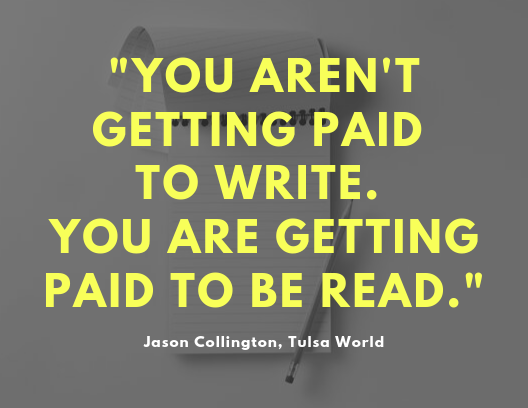Regarding the above graphic and the headline: Save your angry, how-dare-a-school-for-journalists-say-this emails for a moment, please. Great reporting and writing are the foundations of what we do. They combine to uncover widespread and unreported abuses, prompt government officials to take action and often, give voice to the forgotten.
In generations of journalism, that hasn’t changed.
But a lot has.
Last month at the Society for Features Journalism’s annual conference in Detroit, I, along with Poynter managing editor Barbara Allen, presented a talk about what you have to do to get your work the audience it deserves.
We were also dressed up in ‘80s outfits.
It all started with a desire to not only help a small group of dedicated journalists but to have some fun with a wild idea … like wearing ’80s costumes. Hence, the brick phone became our metaphor.

Those were great (if you were rich enough to have one. We weren’t.) But cell phones now do so much more than just make calls. And features journalism now needs more than just great reporting and writing alone.
Here are four of the elements we highlighted from our coverage of the transformation of local journalists and newsrooms for a digital age.

One of the coolest shifts in journalism in the past five years has been the transformation of the beat. Quartz coined the idea of “obsessions,” and some local newsrooms have run with it. The shift moves coverage from buildings and institutions to people and phenomena. So the city hall beat becomes the taxpayer beat. Or the food beat becomes (at least in Texas), the BBQ and tacos beats.
At The Dallas Morning News in 2016, this was an early strategy. In 2019, the newsroom experimented with weather coverage and found a loyal audience for weather stories that offered context and utility. These weren’t just “here’s the weather,” stories, but rather asked questions, like, which Texas cities have the coolest summers and why does it take so much longer for fall to arrive?
Southern California News Group tried something similar with its entertainment coverage. How could it compete with the nearby Los Angeles Times? By going hyperlocal on stories about “The Real Housewives of Orange County,” and by thinking about coverage as fans, not journalists. That resulted in newsletters devoted to theme parks, casinos and music festivals, all which have open rates of 25% and higher.
“We go to Disneyland and Coachella, too,” Vanessa Franko, SCNG’s digital director of entertainment, told Poynter in June, “so we can tell you what’s worth waiting in line for and what you can skip.”
(There are also great and established tools for newsrooms that help journalists listen and rethink how they work, including Hearken and GroundSource.)

You know how much time you spend on your leads? You have to do that with your headlines now, too.
We’ve had our own experiences with this at Poynter and seen how a good headline can help a worthy story sink or soar. The advice on this one is simple: Workshop them.
Many newsrooms, including ours, have a “headline workshop” Slack channel that invites people who aren’t close to the story to take part. (Ours is called “headline improv.”)
An example from our own channel this week was this: “Northeastern professors offer one solution to the problems with traditional student media and community news.”
And here’s the headline that was published: “How this j-school brought real-world reporting into the classroom.”
Good headlines aren’t clickbait; they’re a promise that the story fulfills. They’re also either the front door or the exit ramp to your story.
If you’re not helping to write your own headlines, you’re missing out on your first shot at readers.

Most newsrooms by now have access to analytics through a variety of tools, including Chartbeat, Parse.ly, Omniture and Google Analytics. Those real-time spikes and valleys can be thrilling and depressing. But there’s more to what the numbers can tell you, including what you should and should not be covering.
In California, The Fresno Bee tried short-term food coverage experiments. The team wanted to see what audiences responded to, what they weren’t reading and how they could make adjustments. Here’s what they discovered:
- People loved high-utility coverage, like restaurant openings and closings.
- They didn’t love a localized national story.
- The day the story was published online mattered (no one read them on Fridays).
- And food/culture stories still performed well.
Related training: Audience analytics for reporters
Many newsrooms are moving beyond the popularity contest of pageview metrics, but analytics can tell you other important things.
In Fresno, for instance, the food writer’s experimental coverage was:
- First in the newsroom in direct subscription conversions.
- Second in the newsroom in stories that led to a conversion.
- First in subscriber pageviews.
- And yes, first in pageviews.
Those numbers show this is the kind of work that readers not only want but will pay for.
One more example: In April, Poynter wrote about how The (Charleston, South Carolina) Post and Courier grew digital subscriptions by 250%. Part of their strategy included publishing fewer stories.
You read that correctly.
Editor Mitch Pugh told Poynter that the newsroom learned to stop focusing on clicks and pageviews and instead to focus on time spent and subscription conversions (these are stories that directly lead people to subscribe or to indirectly do so by being on the path to a subscription).
Stories had to have at least 500 unique visitors and at least 1.2 minutes of engaged time. If a story failed those benchmarks, parts of the story were reevaluated (like the headline.) If they still didn’t perform well, the newsroom stopped doing them.
One example we wrote about in April: crime briefs.
Routine crime stories, even a fatal accident, that automatically would have been a story in the past are not now necessarily a story. The audience wasn’t reading them.
The Post and Courier still covers crime, but the focus now is on trends and solutions, Pugh said, “more the how and why and not just that this happened. That was a tough thing to give up. It was ingrained in our culture; this is what we do.”

Most of us spend hours on every story gathering facts, syncing up information and carefully deciding word by word what to include, what to leave out and how to perfectly structure our narrative. Consider your relationship to details — if they are so important during the newsgathering and writing process, why stop there?
If your goal is to get as many eyes on your work as possible (and it is), you’ve got to pay attention to all the details that make your story a package. That includes headlines, subheads, photos, cutlines and links. It means writing three or four great tweets and a really compelling Facebook post (and suggesting graphic elements for each). It means constantly setting high standards for your content based on what your audience needs and wants.
The best part about being so detail-oriented is the relationship you’ll establish with your editor, who is going to deeply appreciate your commitment. A staffer who consistently demonstrates attention to detail often ignites within an editor a powerful relationship dynamic.
And when you have an editor who trusts you and appreciates your work, you might just see your stock rise. The result is momentum internally and externally — wins for your organization and for your readers/viewers.
Kristen Hare covers the transformation of local news for Poynter.org. She can be reached at khare@poynter.org or on Twitter at @kristenhare
Barbara Allen, managing editor of poynter.org, also contributed to this story. She can be reached at ballen@poynter.org or on Twitter @barbara_allen_







